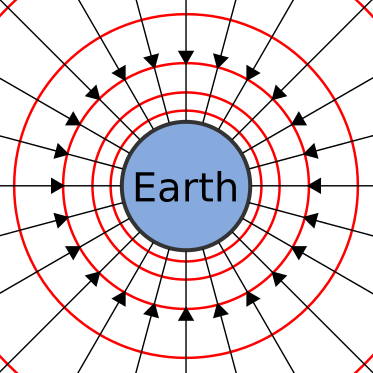What is Electricity?
Electric Fields
We have a handle on how electrons flow through matter to create electricity. That's all there is to electricity. Well, almost all. Now we need a source to induce the flow of electrons. Most often that source of electron flow will come from an electric field.
What's a Field?
A field is a tool we use to model physical interactions which don't involve any observable contact. Fields can't be seen as they don't have a physical appearance, but the effect they have is very real.
We're all subconsciously familiar with one field in particular: Earth's gravitational field, the effect of a massive body attracting other bodies. Earth's gravitational field can be modeled with a set of vectors all pointing into the center of the planet; regardless of where you are on the surface, you'll feel the force pushing you towards it.
The strength or intensity of fields isn't uniform at all points in the field. The further you are from the source of the field the less effect the field has. The magnitude of Earth's gravitational field decreases as you get further away from the center of the planet.
As we go on to explore electric fields in particular remember how Earth's gravitational field works, both fields share many similarities. Gravitational fields exert a force on objects of mass, and electric fields exert a force on objects of charge.
Electric Fields
Electric fields (e-fields) are an important tool in understanding how electricity begins and continues to flow. Electric fields describe the pulling or pushing force in a space between charges. Compared to Earth's gravitational field, electric fields have one major difference: while Earth's field generally only attracts other objects of mass (since everything is so significantly less massive), electric fields push charges away just as often as they attract them.
The direction of electric fields is always defined as the direction a positive test charge would move if it was dropped in the field. The test charge has to be infinitely small, to keep its charge from influencing the field.
We can begin by constructing electric fields for solitary positive and negative charges. If you dropped a positive test charge near a negative charge, the test charge would be attracted towards the negative charge. So, for a single, negative charge we draw our electric field arrows pointing inward at all directions. That same test charge dropped near another positive charge would result in an outward repulsion, which means we draw arrows going out of the positive charge.
Groups of electric charges can be combined to make more complete electric fields.
The uniform e-field above points away from the positive charges, towards the negatives. Imagine a tiny positive test charge dropped in the e-field; it should follow the direction of the arrows. As we've seen, electricity usually involves the flow of electrons--negative charges--which flow against electric fields.
Electric fields provide us with the pushing force we need to induce current flow. An electric field in a circuit is like an electron pump: a large source of negative charges that can propel electrons, which will flow through the circuit towards the positive lump of charges.


